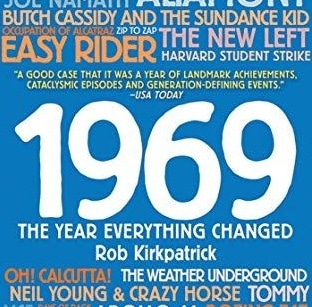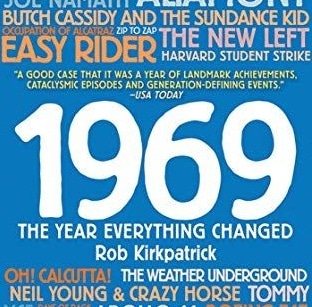Fifty years ago this week, on July 3, 1969, Rolling Stones guitarist and founder Brian Jones was found dead in his swimming pool. The death was ruled to be accidental, but to this day, conspiracy theories circulate that he was murdered. Jones had actually been forced out of the band earlier that year, and replaced by Mick Taylor (leading to the period when the Stones created their best music, IMO), but still, it was a pretty momentous event in the history of rock and roll.

It was just one thing that happened that summer that is still producing aftershocks five decades later. The summer of 1969—50 years ago—was chock full of events that still hold a lot of cultural significance today. I’ve been reading the book 1969, The Year Everything Changed by Bob Kirkpatrick, and it’s eye-opening just how much happened that year, and that summer in particular. To wit:
June 22—The Cuyahoga River in Cleveland, long a dumping spot for pollution and wastes, caught fire. It wasn’t the first time that river burned, but it was the last; and it helped spark a major environmental movement that resulted in the passage of the National Environmental Policy Act at the beginning of 1970, and the Clean Water Act a couple of years later.
June 28—The Stonewall riots took place in New York City; by many accounts, this marked the birth of the modern gay-rights movement.
July 4—The “Zodiac” kills a woman in Vallejo, Calif., and begins taunting police and the media with clues about his identity. OK, not a lot of cultural significance there, unless you’ve ever watched a television cop show.
July 18—Sen. Ted Kennedy drove off a bridge on Chappaquiddick Island, Mass., in a late-night accident that resulted in the death of the woman riding in the car who wasn’t his wife; he left the scene of the accident and didn’t report it until the next morning. Until that night, he was presumed to have a bright political future, but the Chappaquiddick accident dogged him for the rest of his life.
July 20—The astronauts of the Apollo 11 mission became the first to walk on the moon.
August 8 and 9—Charles Manson’s “family” murdered actress Sharon Tate and six others in Los Angeles; Manson claimed to be getting messages from the Beatles’ White Album.
And of course, August 15-18—the Woodstock Music & Arts Festival, billed as “Three Days of Peace and Music,” but in reality it was four days of mud and confusion and overcrowding, but it remains arguably the biggest touchstone of a generation.
(Let me just add here that, except for the moon landing, I had almost no idea about most of these events at the time; it wasn’t until years later—in some cases decades later— before I even knew about some of them, let alone began to understand their significance. Part of the reason for that was that another event that occurred that summer—right between the Apollo 11 launch and the actual moon walk—was my 10th birthday, and I guess a 10-year-olds in those days didn’t concern themselves with senators behaving badly or mass murderers or even rock music festivals.)
And that was just the summer. The year also featured a springtime of student uprisings on college campuses all over the country, the Jets improbably winning the Super Bowl; the Mets equally improbably winning the World Series; the releases of eye-opening movies like Easy Rider and Bob & Carol & Ted & Alice; and the disastrous Rolling Stones concert at Altamont, among many others.
It was quite a year. The book I’m reading does a good job of explaining the events and the context behind them and their historical significance. It’s not a perfect book; there are a handful of glaring errors that a good copy editor should have caught, like when the author refers to the Cubs being on the South Side of Chicago.
Still, though, it’s worth a read, just to have a window into a different era, one that still resonates a half-century later.


July 6, 2019
Great post, John. Thanks for mentioning the Mets!
July 6, 2019
Yes, along with Charles Manson! 🙂